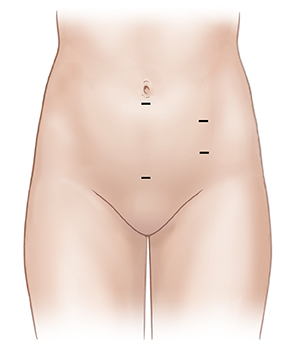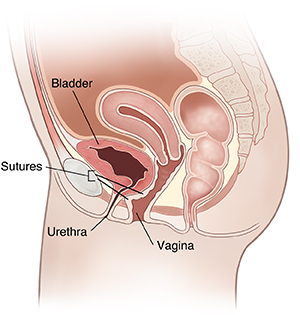A
B
C
D
E
F
G
H
I
J
K
L
M
N
O
P
Q
R
S
T
U
V
W
X
Y
Z
Topic IndexLibrary Index
Click a letter to see a list of conditions beginning with that letter.
Click 'Topic Index' to return to the index for the current topic.
Click 'Library Index' to return to the listing of all topics.
Laparoscopic Retropubic Suspension
To help treat stress urinary incontinence, your surgeon may do a procedure called retropubic suspension. The surgery is done through small incisions in the belly. This type of surgery is called laparoscopic surgery. During the surgery, stitches (sutures) are used to firmly support the pelvic organs and help prevent urine from leaking out. Your surgery will take about 2 hours. You may need to do some things at home to prepare for surgery. Below are guidelines to help you get ready. If you have any questions, call your healthcare provider.
How should I prepare for the surgery?
The weeks before surgery
-
Tell your healthcare provider about aspirin and other medicines, vitamins, or herbs you take. Ask if you should stop taking them before surgery.
-
Stop smoking to help reduce your risks during and after surgery.
-
If you have been given any prescriptions to fill, do this before surgery.
The night before surgery
-
You may be asked to give yourself an enema. This cleans out your bowels for surgery. You’ll be told how to do it should you need it.
-
You will be given directions about eating and drinking before surgery. Be sure to follow these directions. Don't eat, drink, or chew anything, as instructed. This includes water and chewing gum. But if you’ve been told to take any medicines, swallow them with small sips of water.
The day of surgery
Arrive at the hospital a few hours before surgery as directed. Have someone drive you there who can also stay during the surgery and drive you home. At the hospital, you will be asked to read and sign a form giving the surgeon permission to do the surgery. This form is called an informed consent. Read the form carefully and ask questions if something is not clear. Make sure all your questions are answered before you sign the form. Your temperature and blood pressure will be taken. In some cases, tests may be done. Then, 1 or more IV (intravenous) lines will be placed. These lines are used to give you fluids and medicines before, during, and after surgery. Some of your pubic hair may be removed. You may also have snug elastic stockings put on your legs to help prevent blood clots.
About anesthesia
To keep you pain-free during surgery, you’ll receive anesthesia. General anesthesia puts you in a sleep-like state. Regional anesthesia numbs the lower part of your body. Local anesthesia numbs the area that will be operated on. Before surgery, you’ll meet with the anesthesiologist or nurse anesthetist. They can tell you what kind of anesthesia you will receive and answer questions you may have.
What happens during the procedure?
-
Small cuts (incisions) are made in the belly.
-
A thin, telescope-like tool (laparoscope) is put into the belly through one of the cuts. This lets the surgeon look inside your body.
-
The surgeon does the surgery through the other small cuts. Stitches are put through the tissue next to the vagina to help support the urethra and bladder and keep them firmly in place. This helps keep the urethra from moving down and opening by accident.
-
The cuts are closed with sutures, staples, or surgical tape.
 |
| About 2–4 small incisions are made in the belly. |

What are the risks and possible complications?
The risks and complications of this procedure may include:
Online Medical Reviewer:
Donna Freeborn PhD CNM FNP
Online Medical Reviewer:
Marc Greenstein MD
Online Medical Reviewer:
Raymond Kent Turley BSN MSN RN
Date Last Reviewed:
3/1/2022
© 2000-2025 The StayWell Company, LLC. All rights reserved. This information is not intended as a substitute for professional medical care. Always follow your healthcare professional's instructions.